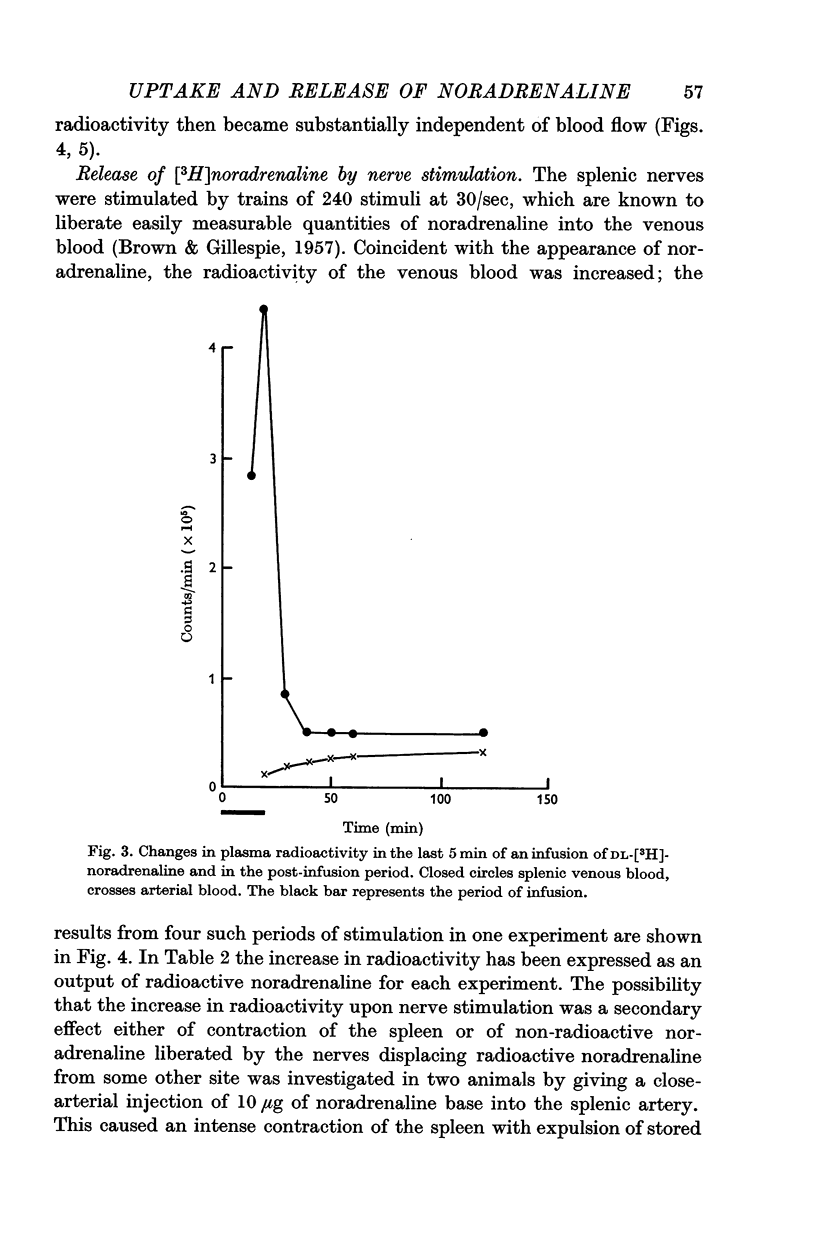Abstract
1. DL-[3H]noradrenaline was infused close-arterially into the spleens of chloralosed cats at rates of 0·625 or 1·25 μg/min for 10 or 20 min and the recovery of noradrenaline and its metabolites in the venous blood measured during the infusion and after nerve stimulation at various times after the infusion.
2. During the infusion 41% of the noradrenaline was recovered in the blood as such and 11% as metabolites. The remaining 48% was retained within the spleen.
3. The noradrenaline retained in the spleen was slowly released to appear as metabolites in the blood stream. In normal animals the rate of loss from the spleen was 0·22% per minute. In animals given phenoxybenzamine after the end of the infusion this rate was several times greater.
4. Splenic nerve stimulation in normal animals or in animals treated with phenoxybenzamine resulted in an increase in the radioactivity of the blood leaving the spleen. Paper chromatography showed this to be radioactive noradrenaline.
5. In normal animals the specific activity of the transmitter liberated by nerve stimulation was less than that of the stores of noradrenaline within the spleen. In animals treated with phenoxybenzamine these two values were similar.
6. It is suggested that the infused noradrenaline retained in the spleen is largely taken up into nerve fibres and is available for subsequent release by nervous activity.
Full text
PDF

















Selected References
These references are in PubMed. This may not be the complete list of references from this article.
- BERTLER A., CARLSSON A., ROSENGREN E. A method for the fluorimetric determination of adrenaline and noradrenaline in tissues. Acta Physiol Scand. 1958 Dec 15;44(3-4):273–292. doi: 10.1111/j.1748-1716.1958.tb01627.x. [DOI] [PubMed] [Google Scholar]
- BROWN G. L., DAVIES B. N., FERRY C. B. The effect of neuronal rest on the output of sympathetic transmitter from the spleen. J Physiol. 1961 Dec;159:365–380. doi: 10.1113/jphysiol.1961.sp006814. [DOI] [PMC free article] [PubMed] [Google Scholar]
- BROWN G. L., GILLESPIE J. S. The output of sympathetic transmitter from the spleen of the cat. J Physiol. 1957 Aug 29;138(1):81–102. doi: 10.1113/jphysiol.1957.sp005839. [DOI] [PMC free article] [PubMed] [Google Scholar]
- GILLESPIE J. S., KIRPEKAR S. M. THE INACTIVATION OF INFUSED NORADRENALINE BY THE CAT SPLEEN. J Physiol. 1965 Jan;176:205–227. doi: 10.1113/jphysiol.1965.sp007545. [DOI] [PMC free article] [PubMed] [Google Scholar]
- GREEN H., ERICKSON R. W. Effect of trans-2-phenylcycloproplylamine upon norepinephrine concentration and monamine oxidase activity of rat brain. J Pharmacol Exp Ther. 1960 Jul;129:237–242. [PubMed] [Google Scholar]
- Gillespie J. S., Kirpekar S. M. The histological localization of noradrenaline in the cat spleen. J Physiol. 1966 Nov;187(1):69–79. doi: 10.1113/jphysiol.1966.sp008076. [DOI] [PMC free article] [PubMed] [Google Scholar]
- HERTTING G., AXELROD J. Fate of tritiated noradrenaline at the sympathetic nerve-endings. Nature. 1961 Oct 14;192:172–173. doi: 10.1038/192172a0. [DOI] [PubMed] [Google Scholar]
- IVERSEN L. L. THE UPTAKE OF NORADRENALINE BY THE ISOLATED PERFUSED RAT HEART. Br J Pharmacol Chemother. 1963 Dec;21:523–537. doi: 10.1111/j.1476-5381.1963.tb02020.x. [DOI] [PMC free article] [PubMed] [Google Scholar]
- KOPIN I. J., BRIDGERS W. Differences in D- and L-norepinephrine-H3. Life Sci. 1963 May;5:356–362. doi: 10.1016/0024-3205(63)90169-3. [DOI] [PubMed] [Google Scholar]
- MAICKEL R. P., BEAVEN M. A., BRODIE B. B. IMPLICATIONS OF UPTAKE AND STORAGE OF NOREPINEPHRINE BY SYMPATHETIC NERVE ENDINGS. Life Sci. 1963 Dec;12:953–958. doi: 10.1016/0024-3205(63)90064-x. [DOI] [PubMed] [Google Scholar]
- ROSELL S., AXELROD J., KOPIN I. J. RELEASE OF TRITIATED EPINEPHRINE FOLLOWING SYMPATHETIC NERVE STIMULATION. Nature. 1964 Jan 18;201:301–301. doi: 10.1038/201301a0. [DOI] [PubMed] [Google Scholar]
- ROSELL S., KOPIN I. J., AXELROD J. FATE OF H3-NORADRENALINE IN SKELETAL MUSCLE BEFORE AND FOLLOWING SYMPATHETIC STIMULATION. Am J Physiol. 1963 Aug;205:317–321. doi: 10.1152/ajplegacy.1963.205.2.317. [DOI] [PubMed] [Google Scholar]
- SPECTOR S., MELMON K., SJOERDSMA A. Evidence for rapid turnover of norepinephrine in rat heart and brain. Proc Soc Exp Biol Med. 1962 Oct;111:79–81. doi: 10.3181/00379727-111-27710. [DOI] [PubMed] [Google Scholar]
- UDENFRIEND S., ZALTZMAN-NIRENBERG P. NOREPINEPHRINE AND 3,4DIHYDROXYPHENETHYLAMINE TURNOVER IN GUINEA PIG BRAIN IN VIVO. Science. 1963 Oct 18;142(3590):394–396. doi: 10.1126/science.142.3590.394. [DOI] [PubMed] [Google Scholar]
- VON EULERU, LISHAJKO F. UPTAKE OF L- AND D-ISOMERS OF CATECHOLAMINES IN ADRENERGIC NERVE GRANULES. Acta Physiol Scand. 1964 Mar;60:217–222. doi: 10.1111/j.1748-1716.1964.tb02884.x. [DOI] [PubMed] [Google Scholar]


